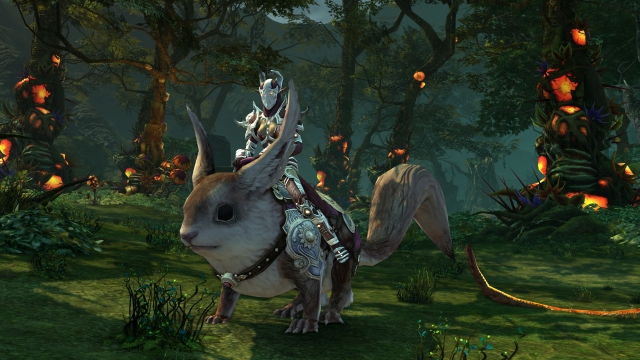Games get popular at times. You might roll your eyes at that and say that it’s obvious, and in some ways it is. When a new World of Warcraft expansion hits? Popularity goes up. Major Final Fantasy XIV patch? Popularity goes up. League of Legends adds in a massively overpowered hero? Popularity goes up, at least until that hero is nerfed into the ground. And that’s not counting bounces from bits of pop culture and the like, like people suddenly jumping into Star Wars: The Old Republic around December because some film franchise releases a new installment. I don’t remember which one. James Bond, maybe.
But when you’re in those games, these surges mean something. If your game was looking like a bit of a ghost town beforehand, suddenly it’s populated. If it always features a healthy population, suddenly it’s crowded. There are a bunch of additional people around unexpectedly.
And this is great! It means a lot of new people are coming in and experiencing a game that you love to no end; that’s wonderful. What is less wonderful is that you know most of them are going to come in, experience it, and then leave. And they aren’t looking at it that way. They show up, they talk about enjoying themselves, and then one day they’re just… gone. Like a relationship in college, they thought they were sticking around, but they were really just on the tour.
When you’re working as part of a guild, you have to be aware of these things. And the thing is, a guild can grow, and grow permanently, as a result of these population surges. You just have to know what you’re doing. So let’s talk about making these short-term population surges work for you.

Decide who you’re courting
There are three groups of players to court in these population surges, and you can court one of them. That’s it. Make your choice early, and make it well.
The first group are visitors. Visitors are new to the game, but they joined in the huge mass of other people checking it out for the first time. They are quite possibly new to the entire genre and still have a lot of wide-eyed enthusiasm, and every new experience they have in the game is really cool because it has literally no equivalent. And, on the generous side, I’d say about 10% of them will stick around after the surge dies down; give it about three months.
The second group are returners. Returners are not, in this case, rebels from Final Fantasy VI; they’re former players who stopped playing for a while for a variety of reasons, but all of the buzz brought them back in. What level of play they previously engaged in can wildly vary, but on an average I’d say about half of them will stick around for at least six months after they head back. They also tend to be very knowledgeable about the game, or at the least not much less so than your average active player.
Speaking of which, that third group is players. We’re talking the people who are still there and were playing before the population boom started. These people are likely to stick around simply because they were already around; if they were going to leave, they wouldn’t do so while the game is on an uptick. You might think that this group can’t be courted during a boom, but there will always be people who want to play with other committed players rather than folks who swarmed in on the back of a movie/book/comic/whatever.
If you’re going to make use of the population surge, pick a group and court them. My personal preference here is usually to court the returners, because they’re the sort of people who already have incentive to come back and just need the anchor a guild can provide. It’s not a certainty, but it’s better than even odds. But there are plenty of reasons to pick another group to court; just pick one and stick with it.

Nudge but don’t deform
So you’ve decided which group you’re courting. Great! Now comes the tricky part – nudging your focus just enough that it includes the people you’re courting without alienating the people already in the guild.
If you’ve got a hardcore progression group, you do not want to be mixing in visitors in the group. Yes, there’s a small chance that people will see you talk about progression and say “wow, that sounds so cool,” but more likely you’ll be splitting your time and attention between two radically different groups with extremely different needs. The visitors won’t feel included, and your existing guild members won’t feel as if they have a place amidst your swarm of visitors… and when the surge ends, you’re left with no one.
This is where picking a group and running with it becomes important. A hardcore progression group can definitely court existing players, because it can bring them into the fold without having to worry about coaching new people. A more casual or dungeon-focused group can court returners or visitors. A group focused on teaching newer players how to play should be courting visitors left and right; sure, a lot of them will leave, but the ones who stick around will both be in a position to teach and will have the guild as their anchor for learning.
Your key is gently nudging your overall focus rather than actually pushing it off. If you have a dungeon-focused group in Final Fantasy XIV, for example, you would be well-served by having a few more lower-level or inclusive runs… stuff that people can clear if they’ve missed or if they need some obscure content cleared. Make the new players feel as if they’re welcomed and valued, but don’t give your existing players the feeling that continuity has been suspended.

Expect the departures
While I’m normally big on making sure that your guild is the right size for what you want, when you’ve got a population surge, the rules get wonky. You are going to get an influx of new players, and then many of those players are going to be gone before too long. That’s normal, and frankly, it’s all right.
Even if it’s not all right, it’s going to have to be all right, because those players are leaving.
When you know that you’re going to lose some of your members before the ink gets cold on their applications, you have to cultivate a slightly different attitude. You try your best to provide people with a positive anchor, but you cannot be certain that even the veteran players won’t decide that the game isn’t what it used to be and it’s time to leave.
Let yourself get flush with new members, but be aware that the shrink is coming, just as surely. Don’t worry about new officers while the population surges; know that players are going to leave and you’re going to shrink back down to a more reasonable size. Keep your eyes on the longer-term. In three months, a sudden burst of popularity will have faded, and you’ll be able to examine what your guild needs and where it stands in the final assessment.
In all likelihood, if you’re playing it smart, you’ve got a few new members and a slightly quieter game. And that’s all right! It’s a few new members you wouldn’t have had before, and now you can get back down to the usual ebb and flow. Until the next surge, anyhow.







Published: Jul 27, 2016 08:54 am